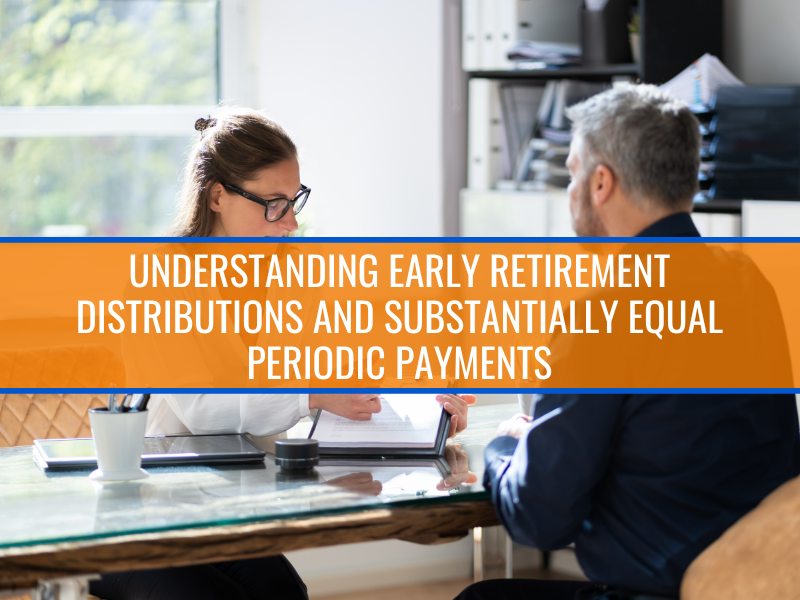If you’ve entered early retirement, drawing from retirement accounts such as IRAs, 401(k)s or 403(b)s may be your best option to maintain a steady income. However, there are tax and penalty considerations to be aware of before making early withdrawals.
We’ll present those considerations here, along with a tax planning technique that can minimize early withdrawal penalties through the use of substantially equal periodic payments (SEPP).
A Summary of Retirement Accounts and Taxes
For many people entering (or forced into) early retirement, it can be difficult to maintain a steady income, especially if Social Security isn’t yet an option and you may not have a pension to draw from.
Retirement account distributions can offset any loss of income, but early distributions (those made before turning 59 ½) and pre-tax contributions are governed by the following rules:
- All IRA withdrawals are subject to income taxes at the taxpayer’s normal income tax rate.
- With few exceptions, any taxable withdrawal out of a retirement account is also subject to a 10 percent penalty.
- This 10 percent penalty does not apply if the taxpayer takes out a series of substantially equal periodic payments.
With this last point in mind, tax planning professionals frequently use SEPP as a way to reduce their client’s taxes.
How to Avoid Early Withdrawal Penalties: Substantially Equal Periodic Payments
The IRS allows early retirees to avoid the 10 percent early withdrawal penalty if three conditions are met. They include:
- Withdrawals are calculated and paid out using one of three calculation methods – the required minimum distribution method, the fixed amortization method, or the fixed annualization method.
- Withdrawals are made at least annually during the SEPP plan’s payment years. If desired, early retirees may make more frequent withdrawals, such as monthly payments. However, the total amount withdrawn for the year must meet the SEPP calculation for that payment year.
- SEPP payments must be made for either a period of five consecutive years or until the taxpayer reaches 59 ½ years of age – whichever is later.
The IRS is extremely strict on how SEPP payments are managed, so it’s critical for taxpayers to accurately calculate their SEPP payments before taking withdrawals.
Three Ways to Calculate SEPP
The IRS accepts one of three calculation methods when determining SEPP payments. They include:
- The required minimum distribution method – With this method, the account balance and annual payment are redetermined every year. To calculate the payment amount, taxpayers must reference the IRS Uniform Lifetime Table to determine their life expectancy factor and divide the account balance by this factor. The life expectancy factor also changes every year, which affects the payment amount.
- The fixed amortization method – With this method, the taxpayer uses the IRS’s life expectancy tables (the Single Life Table, for example) and a reasonable interest rate (not to exceed 5 percent) to calculate annual SEPP payments. To do this, the taxpayer’s account balance is divided and paid out in equal amounts year-over-year during the SEPP payment period.
- The fixed annualization method – This method is similar to the fixed amortization method, in that payments are the same year-over-year. Another similarity – payments are calculated by dividing the account balance by a number of years derived from an IRS mortality table. The only difference is the table that is used. With the fixed annualization method, the relevant table is the UP-1984 Mortality table. In most cases, this method provides the largest SEPP payments.
With one exception, retirees may not modify their calculation method once payments are started. A retiree may switch from either a fixed amortization or annualization method to the required minimum distribution method. Once they do so, the switch is permanent and is used to calculate payments for all future SEPP years.
Additional SEPP Considerations: Changes to Account Balance or Account Depletion
There are strict rules governing how SEPP payments and accounts are handled. A couple of which include:
- Changes to account balance – Once an early retiree begins taking SEPP withdrawals from their retirement account, no other contributions or distributions can be made during the SEPP period. This includes nontaxable transfers to or from the account.
- Account funds are exhausted – If, as a result of taking out SEPP payments, the account’s balance is depleted, the taxpayer is not subjected to the 10 percent penalty. If payments are stopped, this is not considered a modification of the series of SEPP payments.
SEPP Payments Come with Risk, So Consult with a Tax Expert First
There are risks involved with SEPP tax planning, so it’s important to consult with a tax professional before taking early retirement account distributions. A reputable bookkeeping service and tax expert can eliminate these risks with long-range, detailed planning.
For example, once SEPP payments begin, taxpayers should exercise extreme caution before altering payment amounts or scheduling. There is nearly zero flexibility in this area. Also, taxpayers must document the calculations used to determine SEPP payments, as well as document any change to those calculations. Tax courts will frequently rule against retirees who cannot verify their calculation methods through documentation.
If this happens, the 10 percent early withdrawal penalty will be applied retroactively to past SEPP payments, as well as all future SEPP payments.
SEPP mistakes can be costly, but your tax expert will ensure you remain in compliance with the Internal Revenue Code and its early retirement distribution rules.
- Inside the Loophole – Best of West Houston 2025 – We Won First Place! Thanks to You! - November 17, 2025
- When Should I Start Planning for Tax Season? - October 14, 2025
- Inside the Loophole – Best of West Houston 2025 – We Need Your Vote! - October 13, 2025

